Randolph Hotel, Oxford
The Randolph Hotel ("The Randolph") is a 5 star hotel in the heart of Oxford, England. It is on the south side of Beaumont Street, at the corner with Magdalen Street, opposite the Ashmolean Museum and close to the Oxford Playhouse. The hotel's architecture is Victorian Gothic in style.
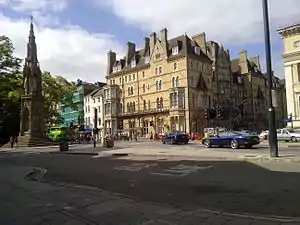
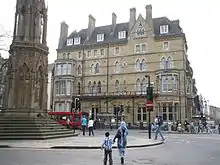
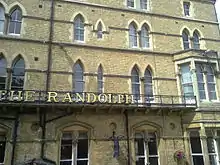
The hotel featured in the Inspector Morse television series several times, in particular in the episode entitled "The Wolvercote Tongue". The cast stayed at the hotel during filming in 1987 and there is now a Morse Bar. It was also in episodes of the Morse followup, "Lewis".
History
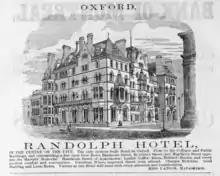
Construction of the Randolph Hotel began in 1864 by William Wilkinson,[1][2] an architect who also designed many houses in North Oxford.[3] There was debate about the building's design. John Ruskin favoured Gothic revival like the nearby Martyrs' Memorial. The City Council wanted a classical style since the rest of Beaumont Street was early 19th century Regency. A compromise was attained with a simplified Gothic façade, similar to the Oxford University Museum and the Oxford Union buildings, but in brick.
The hotel was named not after Lord Randolph Churchill, who was connected with Blenheim Palace to the north of Oxford, but after Dr Francis Randolph, an eighteenth century university benefactor.[4] The University or Randolph Galleries (now part of the Ashmolean Museum) were built as a result of a thousand-pound gift left by Dr Randolph, a former Principal of St Alban Hall (now part of Merton College), who died in 1796.
The hotel was opened in 1866. Major refurbishments of the hotel were undertaken in 1952, 1978, 1988 and 2000. During the 1952 renovations, an extension was added to the west, designed by J. Hopgood.[2]
On 17 April 2015, the Randolph Hotel had a "significant fire"[5] (declared by the Oxfordshire Fire and Rescue Service). The fire was confirmed to have started in the kitchens on the ground floor. The fire spread through building voids eventually reaching the roof. The emergency services were called at 16:46 and came at about 16:52. There were no casualties, and the Oxfordshire Fire Service praised the hotel for its "quick evacuation processes." Certain roads were closed including Beaumont Street, Magdalen Street and St Giles. Cars were diverted via Walton Street and on to St Margaret's Road and Woodstock Road, and taxis and buses diverted via Parks Road, Broad Street and George Street. The fire ended around 20:00. A performance at the Oxford Playhouse at 20:00 went ahead.[6] The fire was caused by the cooking of flambéed beef in the kitchen.[7]
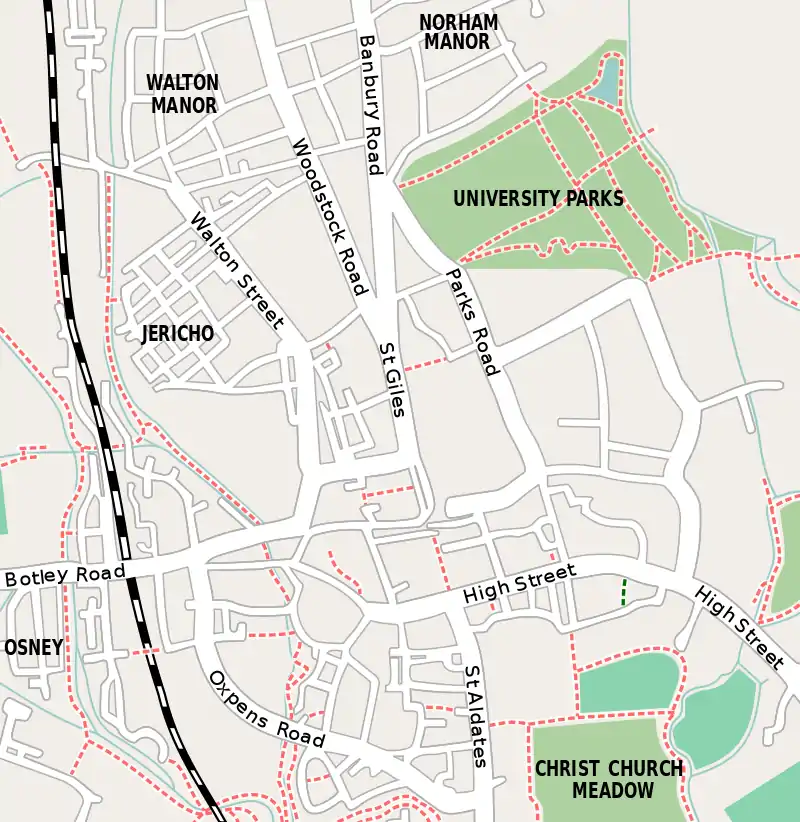
References
- Tyack, Geoffrey (1998). Oxford: An Architectural Guide. Oxford; New York: Oxford University Press. p. 243. ISBN 0-19-817423-3.
- Sherwood, Jennifer; Pevsner, Nikolaus (1974). The Buildings of England: Oxfordshire. Penguin Books. pp. 324–325. ISBN 0-14-071045-0.
- Hinchcliffe, Tanis (1992). North Oxford. New Haven: Yale University Press. ISBN 0-300-05184-0.
- "Celebrating the 150th anniversary of Oxford's most famous hotel ". oxfordtoday.ox.ac.uk. Retrieved on 2018-08-24.
- "Oxford's five-star Randolph Hotel hit by fire". BBC News. BBC. 17 April 2015. Retrieved 11 July 2015.
- "Randolph Hotel: Beaumont Street expected to remain closed until tomorrow as crews deal with hotspots". Oxford Mail. 19 April 2015. Retrieved 20 April 2015.
- "Oxford's Randolph Hotel blaze 'sparked by flambéed beef'". BBC News. BBC. 20 April 2015. Retrieved 20 April 2015.
External links
| Wikimedia Commons has media related to Macdonald Randolph Hotel, Oxford. |